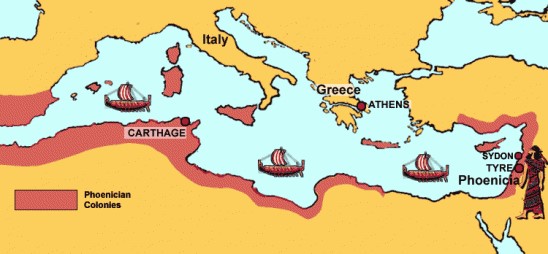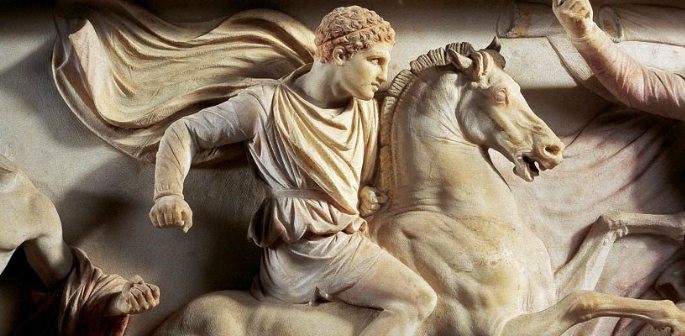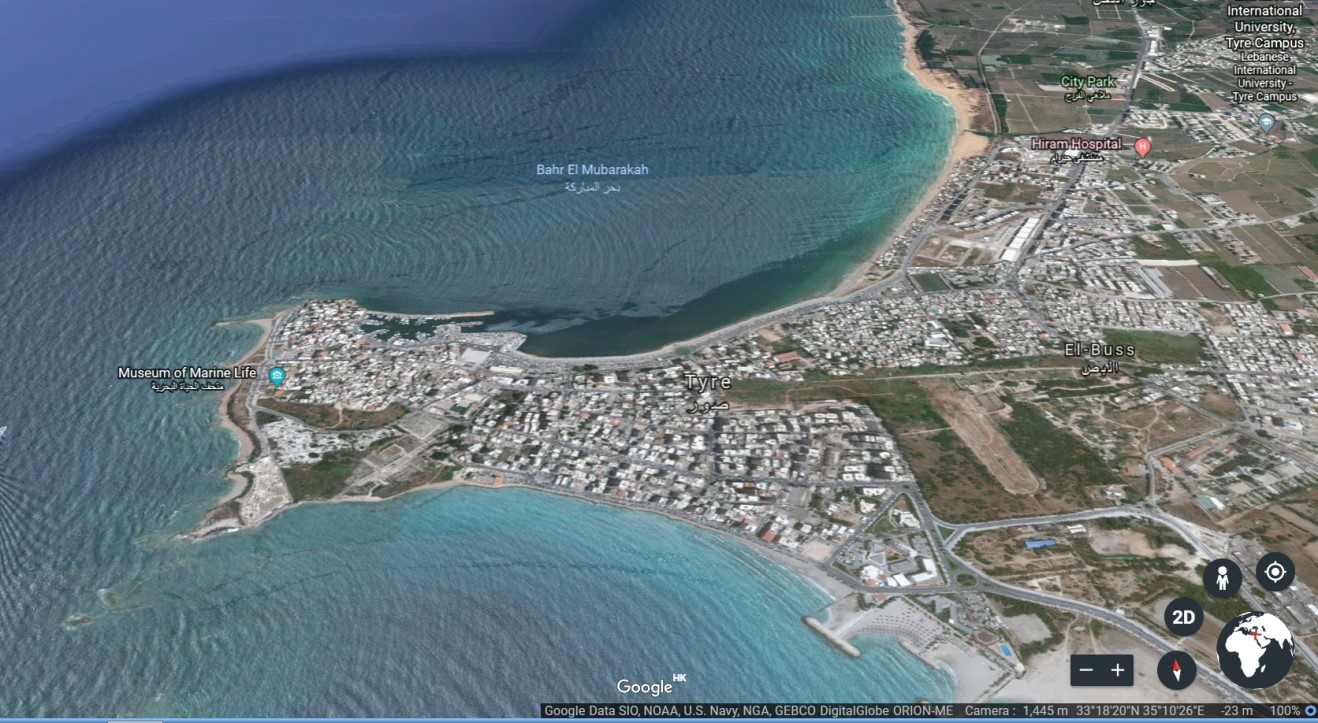Phenomenon of Amazing Detail
The Fall of Tyre
The prophecies concerning the demise of Tyre is another awesome indication of God’s Divine Governance, and of the Amazing Details that are found in the Scripture.
The fall and destruction of Tyre in Phoenicia was covered in three chapters of the book of Ezekiel. It is the lengthiest prophecy on this city in the Old Testament. The most vivid descriptions were made by Ezekiel in Chapter 26 of the book. He made these prophecies between 587-586 BC, some of which were being fulfilled during the reign of Alexander the Great, in 332 BC. When these prophecies were made, Alexander the Great was not even born. Other prophetic text concerning the fate of Tyre are found in other chapters of Ezekiel (27,28) and Amos 1:9-10, Zechariah 9:3-4.
God condemning Tyre with judgments (Ezekiel 26: 1-21)
1 In the eleventh month of the twelfth year, on the first day of the month, the word of the Lord came to me:
2 Son of man, because Tyre has said of Jerusalem, ‘Aha! The gate to the nations is broken, and its doors have swung open to me; now that she lies in ruins I will prosper,’
3 therefore this is what the Sovereign Lord says: I am against you, Tyre, and I will bring many nations against you, like the sea casting up its waves.
4 They will destroy the walls of Tyre and pull down her towers; I will scrape away her rubble and make her a bare rock.
5 Out in the sea she will become a place to spread fishnets, for I have spoken, declares the Sovereign Lord. She will become plunder for the nations,
6 and her settlements on the mainland will be ravaged by the sword. Then they will know that I am the Lord.
7 For this is what the Sovereign Lord says: From the north I am going to bring against Tyre Nebuchadnezzar, king of Babylon, king of kings, with horses and chariots, with horsemen and a great army.
8 He will ravage your settlements on the mainland with the sword; he will set up siege works against you, build a ramp up to your walls and raise his shields against you.
9 He will direct the blows of his battering rams against your walls and demolish your towers with his weapons.
10 His horses will be so many that they will cover you with dust. Your walls will tremble at the noise of the warhorses, wagons and chariots when he enters your gates as men enter a city whose walls have been broken through.
11 The hooves of his horses will trample all your streets; he will kill your people with the sword, and your strong pillars will fall to the ground.
12 They will plunder your wealth and loot your merchandise; they will break down your walls and demolish your fine houses and throw your stones, timber and rubble into the sea.
13 I will put an end to your noisy songs, and the music of your harps will be heard no more.
14 I will make you a bare rock, and you will become a place to spread fishnets. You will never be rebuilt, for I the Lord have spoken, declares the Sovereign Lord……..
19 “This is what the Sovereign LORD says: When I make you a desolate city, like cities no longer inhabited, and when I bring the ocean depths over you and its vast waters cover you,
20 then I will bring you down with those who go down to the pit, to the people of long ago. I will make you dwell in the earth below, as in ancient ruins, with those who go down to the pit, and you will not return or take your place[c] in the land of the living.
21 I will bring you to a horrible end and you will be no more. You will be sought, but you will never again be found, declares the Sovereign Lord."
This is the sixth dated prophecy of Ezekiel and it is the eleventh year in Jehoiakim’s exile. The exact date is not stated but it is the same year as Jerusalem’s fall. As Tyre is rejoicing over it, it is probably soon after this event. Tyre was a great Phoenician city consisting of a flourishing mainland portion and a fortified island half a mile from the coast. The city is famous for its commerce, and in particular the export of a rather unique red-purple dye. It had also become an established "financial center of money trading". Tyre was described in Ezekiel 27 as having “abundant wealth of every kind”.
Tyre was a flourishing center of commerce. It was well situated for trade from the Mediterranean and the mainland.
Tyre was famous for its Tyrian Purple, or royal purple, imperial purple — a red-purple dye made from the mucus of one of several species of Murex snails, first produced by the Phoenicians in the city of Tyre for use as an expensive fabric dye around 1200 BCE. The pigment was rare and complex to produce, and items colored with it became associated with power and wealth, often fetching its weight in silver. It's production was continued by the Greeks and Romans until the fall of Constantinople in the 15th century. Tyre was also famous for its silver coin, the Tyre Shekel, which has a good silver content.
Tyre was a city whose inhabitants are apparently all materialists. Money and commerce reigned supreme. They worshipped the God Mammon and a female deity called Astoreth. In those days Tyre controled very much of the sea trade while Jerusalem controled the caravan routes. The “Aha” of Tyre was malicious as she intended to monopolize the trade of the Middle East. However God always take offence at malicious design against His people. Prophetic judgments were thus declared on Tyre that she would be destroyed by waves of nations. Some were quite remarkable such as v.12-14 “They will plunder your wealth and loot your merchandise; they will break down your walls and demolish your fine houses and throw your stones, timber and rubble into the sea... I will make you a bare rock, and you will become a place to spread fishnets. You will never be rebuilt, for I the Lord have spoken, declares the Sovereign Lord”.
Why was God's wrath so heavy upon Tyre?
What had Tyre done to provoke the great wrath of God? To the king of Tyre God said: ”You’re your great skill in trading you have increased your wealth, and because of your wealth your heart has grown proud.” - Ezek. 28:5 Tyrian’s greediness and boastfulness for wealth led to another sin: Tyre sold Israelites as slaves. It had not always been that way. When Hiram was king of Tyre, relationships between Jerusalem and Tyre were good. Hiram sent David cedar and workmen for his palace and material to Solomon for building God's temple (2Samuel 5:11,7:2; 1Chronicles 22:7, Ezra 3:7). But after the division of the kingdom, relations deteriorated. Tyre filled its slave markets with Jews, selling them to distant countries. The Lord said: “I will send a fire upon the wall of Tyre, and it shall devour her palaces.” - Amos 1:9, 10,
There was even more to Tyre’s guilt in God’s eyes. When the army of King Nebuchadnezzar of Babylon destroyed Jerusalem in 607 B.C., the Tyrians rejoiced! Jerusalem had attracted many merchants, with Jerusalem out of the way Tyre expected more trade for herself. Tyre exulted: “Aha! The gate to the nations is broken, and its doors have swung open to me; now that she lies in ruins I will prosper.” - Ezek. 26:2.
“Thus said the Lord: From the north I am going to bring against Tyre Nebuchadnezzar king of Babylon...” - Ezek. 26:7,.
The details on the full destruction of Tyre is vividly described in 26:7-14 True to the prophecy, and not long after the fall of Jerusalem, the king of Babylon came against Tyre. But Tyre was confident. The city had resisted King Shalmaneser for five years, causing that king to give up the siege. Nebuchadnezzar attacked Tyre again and twelve years passed, Tyre was still resisting. Finally, after thirteen years, the siege engines of Nebuchadnezzar prevailed, and mainland Tyre fell. He campaign was nevertheless very costly to the King of Babylon and its army. “Every head was rubbed bare, and every shoulder made raw; yet he and his army got no reward from the campaign which he led against Tyre.” - Ezek. 29:18. Nebuchadnezzar could not get Tyre’s treasures because during the long siege the bulk of the treasures had been transferred to a small island about half a mile from the mainland (the New Tyre).
Ezekiel plainly showed that God had His plans and Nebuchadnezzar did not go unpaid. He had performed services for the Almighty God in destroying Tyre! As a return for the campaign which he directed against Tyre, “I am going to give Egypt to Nebuchadnezzar king of Babylon, and he will carry off its wealth. He will loot and plunder the land as pay for his army. I have given him Egypt as a reward for his efforts because he and his army did it for me.” - Ezek. 29:19, 20. Shortly afterwards the king of Babylon conquered Egypt and received the country's land and treasures as payment for reducing proud Tyre to a heap of rubbles!
The mainland city was indeed “no more” after the seize of Nebuchadnezzar. The Tyre remains was an island city of about 150 acres. To get as many people on the island as possible the Tyrians built their houses several stories high. With time, Tyre again became a strong and prosperous city. Tyre’s god was still Mammon. Describing new Tyre, the island city, God’s prophet Zechariah said: “Tyre has built herself a stronghold, she has heaped up silver like dust, and gold like the dirt of the streets.” - Zech. 9:3. “The Lord will take away her possessions, and destroy her power on the sea, and she will be consumed by fire.” - Zech. 9:4.
Babylon’s role ended in v.11 as the pronoun changes from “he” to “they” in v.12-14 and amazingly the details harmonize with Alexander the Great’s well documented conquest of Tyre in 322-333 BC (as well as others that followed)! The time has finally come for God to smite Tyre’s “wealth into the sea.”
In the year 333 B.C. Alexander the Great of Macedonia defeated the Persian king Darius II at the battle of Issus. After engaging in several cities along the Phoenecian coast from Cyprus, Aradus Byblus and Sidon, Alexander now has to turn his attention to Tyre. Alexander asked to enter the city to offer sacrifice in the great temple of Melkarth. The Tyrians refused. They were willing to have the Macedonian monarch as friend but not as master. Alexander, enraged at the stubbornness of the Tyrians, determined to take the city knowing its difficulty as being an island.
Alexander built an astonishing causeway
So as to attack Tyre’s walls, Alexander put his army to work building a causeway to the island. Where did Alexander find materials to build his causeway? Right! from the massive ruins of old Tyre, just as Prophetic Ezekiel had predicted years beforehand! “They will destroy the walls of Tyre and pull down her towers; I will scrape away her rubble and make her a bare rock... and throw your stones, timber and rubble into the sea.” - Ezek. 26:4, 12. Indeed so much material was needed that the mainland must have been “I will make you a bare rock, and you will become a place to spread fishnets.” as in Ezek 26:14.
Alexander’s men at first salvaged stones and timber and began building a causeway about 200 feet wide. When more construction materials were needed, Alexander ordered all the debris of the ruined city scraped up and dumped into the water. Thus old Tyre, the mainland city completely perished
The Alexander causeway around 200 feet wide was built for the attack of the New Tyre coast front.
(Map: Atlas of the Bible. LH Grollenberg OP. © Thomas Nelson & Sons Ltd, 1956).
Alexander's siege of Tyre is best described in an animated narrative on YouTube from BazBattles: "The Siege of Tyre 332 BC" - https://www.youtube.com/watch?v=-WkWy47ighY
The siege had never been easy or straight-forward even with the causeway. Progress was made difficult by repeated attacks by Tyrian naval vessels. Eventually Alexander realized he could not succeed without a good navy.
From Cyprus and Sidon, from Aradus and Byblus, Alexander obtained many naval vessels. Finally, he amassed a fleet of some 200 ships. He now had a navy stronger than Tyre’s. With the Tyrian navy bottled up in the harbor, Alexander went to his final attacks.
Soon the causeway was extended to the city walls, walls that towered to a height of 150 feet. Alexander brought up siege engines to hurl arrows, stones and burning torches upon the besieged. Alexander constructed enormous towers about twenty stories high; the topmost platforms towered to a height of more than 160 feet. At last, after seven months of siege, in August, 332 B.C., Alexander’s soldiers forced its way into Tyre’s harbor. New (Island) Tyre finally fell.
The Macedonian soldiers, filled with anger and frustration at the lengthy siege and the memory of their executed comrades, slaughtered the Tyrian defenders in huge numbers. 8000 Tyrians was slained by the sword, and 30,000 sold into slavery. There was one more detail. Alexander took the island and slaughters thousands of Tyrian soldiers. But his respect for women was legendary and even rape by his soldiers was severely punished. Slaughtering of women apparently had only occurred in the mainland. Thus with the destruction of the island city by Alexander the Great and horrible (Ezek 29:21), to the fulfillment of the words of God’s prophets concerning the downfall of ancient Tyre — nearly two hundred years after Zechariah foretold it, nearly three hundred years after Ezekiel foretold it, more than three hundred years after Joel foretold it and more than four hundred years after Amos foretold it!
Here we see that the amazing detail about the two phases of the fall of Tyre pertaining to the mainland and then the island were exactly described in the scripture.
As of the Mainland: Nebuchadnezzar seized Tyre for 13 years and Ezek 26:8 correctly predicted that it is the mainland that was taken but yet it was not the entire city. In 29:18 it says he did not get any wages from Tyre although he was “rewarded” by other conquests.
As of the Island: It was taken by Alexander the Great at a later date who took the whole island and really scrapped away all the mainland rubbles by building the causeway. (Ezek 26:4). The conquest was horrifying and much of all the land cannot be used. (Ezek 26:19-21)
These details in the scripture with such accuracy in time, sequence and scale are truly and incredibly amazing!
Years that followed
In the years that followed Alexander’s conquest of Tyre, the island city managed to rebuild itself a number of times, only to be conquered by many nations. The last trace of Tyre’s independent existence was taken from it by the Roman emperor Augustus. A.D. 638. Tyre was subsequently captured by the Muslims, and in 1124 Tyre was occupied by the Crusaders. The crusaders lost it in 1291, when the city was turned to heaps of stones. After its capture by the Turks in 1516, Tyre had became a desolation! The ancient island, now a peninsula, is connected with the mainland by a tongue of land (building on Alexander's initial 200 feet causeway) almost half a mile broad. Once a center of world commerce, Tyre now carries on an insignificant trade in cotton and tobacco; and its fishermen have acres of desolate space to spread out their nets to dry.
“Therefore this is what the Sovereign Lord says: I am against you, Tyre, and I will bring many nations against you, like the sea casting up its waves” - The prophecy of the “waves” of destruction as seen in v.3 was also aptly fulfilled, even in the years that followed. .
Tyre Peninsula, Lebanon, as it is today (From Google Earth) At the right lower corner of the picture is part of the old Tyre.
As described in Ezek 26:19, the waters indeed now covers much of that old city in the mainland and in fact the precise location cannot be determined.
According to the Columbia Encyclopedia: "The principal ruins of the city today are those of buildings erected by the Crusaders. There are some Greco-Roman remains, but any left by the Phoenicians lie underneath the present town."
Modern Tyre beach on the eastern side with tourists (from Google Earth), nonetheless not in any big lavishing styles of holidays resorts.
In Verse 14 of Ezekiel 26, it says “14 I will make you a bare rock, and you will become a place to spread fishnets. You will never be rebuilt, for I the Lord have spoken, declares the Sovereign Lord.
Was then the old Tyre rebuilt now? Surprisingly or not surprisingly, it is not! The land is now a World Heritage site! As a significant Wetlands and waterfowl habitat for green turtle and loggerhead turtles! (Ramsar site 980)
From the Ramsar website: “Tyre Beach. 16/04/99; 380 ha. World Heritage Site. The Ramsar site is located within the best preserved stretch of sandy coastline in southern Lebanon; it is remarkable for its biodiversity but threatened by its proximity to the city of Tyre and the Rachidieh refugee camp. Its artesian wells are an important heritage site and give rise to a number of notable freshwater habitats. Beach vegetation is dominated by sea spurge and cotton weed, while the hillocks are dominated by shrubs, grasses and the rush, Juncus”.
https://www.researchgate.net/figure/Location-of-Tyre-Beach-Nature-Reserve-Ramsar-site_fig3_278671826
The amazingly Verse 20 actually says at the end "glory in the land of the living" or more literally (I have given beauty in the land of the living.). The NIV does not translate it that way because they think it does not make sense. Nonetheless Tyre do have some beauty today in the land of the living and it is not a city in total waste. In fact this also fits with Ezek 26:19 which mentions a desolate city "like cities not inhibited” - meaning it is “like” a desolate city but nevertheless not exactly one!
I would also like to ask the critics of the authenticity of the Ezekiel descriptions (being put there after the events have taken place), how the imposter writer could have foreseen these things happening in the twentieth century AD?
The population now of the “New Tyre” runs at around a hundred thousand, many subsisting chiefly on fishing, trades on cotton and tobacco. They seem to be preserved in this place by Divine Governance as a visible evidence of how God has fulfilled his word concerning Tyre. The almighty God sees the end from the beginning.
A brief recap:
Fulfilment of the Tyre prophecies in the Book of Ezekiel:
1. Many nations will come against Tyre Ezek 26:3-4
2. The city will be totally scrapped away... Like a bare rock Ezek 26:5
3. It will become a place for spreading fishnets (indeed not even knowing the precise location) Ezek 26:5,14
4. The city will be attacked by Babylon 26:7 but only in the mainland. Fell to Nebuchadnezzar, king of Babylon. Ezek 26:7-13
5. This was not total destruction as Nebuchadnezzar will not get his wages from Tyre. Ezek 29:18
6. It will be covered by water. Ezek 26:19
7. You will never be rebuilt Ezek 26:24
8. Yet there is some beauty remaining and it will still survive with inhabitants. Ezek 26:20
9. There is a “horrible” end to the city and it will be no more... Ezek 26:21
The Bible reader often looks upon Tyre with huge interest and awe, for few cities afford more striking evidence of the impeccable certainty of God's prophetic messages, and the amazing accuracy of the descriptions in the scripture!






